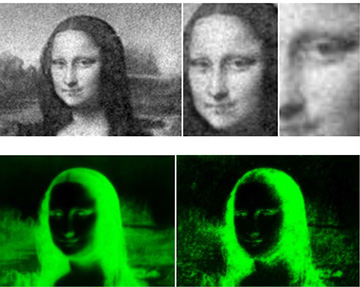
An accurate millimeter-scale replica of Leonardo da Vinci's Mona Lisa, formed by approximately one million E. coli cells that were genetically engineered to respond to light. Bottom left and right images are before and after activating the feedback loop, respectively. [Image: Frangipane et al., 2018]
A team of Italian scientists has discovered a surprisingly artistic use for E. coli. By genetically engineering the bacteria to respond to light, the team has demonstrated a way to shape E. coli into complex, reconfigurable density patterns—such as Leonardo da Vinci’s “Mona Lisa”—using only a low-power projector (eLife, doi: 10.7554/eLife.36608.001).
Light-engineering E. coli
Many bacteria move in response to environmental signals. Oceanic bacteria containing the protein proteorhodopsin even use light to power their movements—the more light there is, the faster the bacteria can swim. E. coli in particular are known to be very fast swimmers, capable of swimming a distance that’s 10 times their length in one second. But that’s thanks to the bacterium’s propeller-like structures rather than to proteorhodopsin, which doesn’t naturally occur in E. coli.
The “propellers” of E. coli are powered by a flagellar motor, which recharges through an oxygen-dependent process. Scientists from the Sapienza University of Rome’s Institute of Nanotechnology realized that by using proteorhodopsin to re-engineer this process to be light-dependent instead of oxygen-dependent, they could essentially place a solar panel on each bacterial cell and control its speed with light.
Just like cars stuck in traffic on the highway, bacteria spend more time in slower regions than in faster ones—their swimming speed is space-dependent. Thus, controlling speed means controlling density. According to lead author Giacomo Frangipane, “We wanted to exploit this phenomenon to see if we could shape the concentration of bacteria using light.”
An artistic use for bacteria
To study bacterial behavior, the team set up a digital light processing (DLP) projector to shape light with a megapixel resolution and with a dynamic range of 256 (8-bit) light intensity levels. To start, the researchers observed the effect of light on the speed of the photokinetic bacteria while projecting a chessboard pattern of varying light intensity, and then examined the relationship between speed and density using differential dynamic microscopy (DDM).
Next, the team projected a microscopic black-and-white negative image of the Mona Lisa onto the bacterial layer and observed as the bacteria eventually concentrated in dark regions of the projection and swam away from the brightest regions. After 4 minutes, the scientists had a somewhat blurry replica of the famous artwork, as revealed by dark field microscopy.
The scientists deduced that the blurriness corresponded to the E. coli’s slow response to the light variations. To remedy this, the team applied a feedback control loop, which compared the bacterial shape to the desired image every 20 seconds and updated the light pattern accordingly. This resulted in a near-perfect millimeter-scale replica of the Mona Lisa comprising approximately 1 million photokinetic cells.
The team also created E. coli portraits of Albert Einstein and Charles Darwin with the light-fueled cells to illustrate the technique’s dynamic and reconfigurable nature. In the video below, an E. coli portrait of Einstein morphs into one of Darwin within the span of a few minutes.
The researchers propose that optically controlling bacteria in this way could someday lead to using genetically modified bacteria as “microbricks” to build next-generation microscopic devices. “With further engineering, the bacteria could be used to create solid biomechanical structures,” says Roberto Di Leonardo of Rome University, “or novel microdevices for the transport of small biological cargoes inside miniaturized laboratories.”
